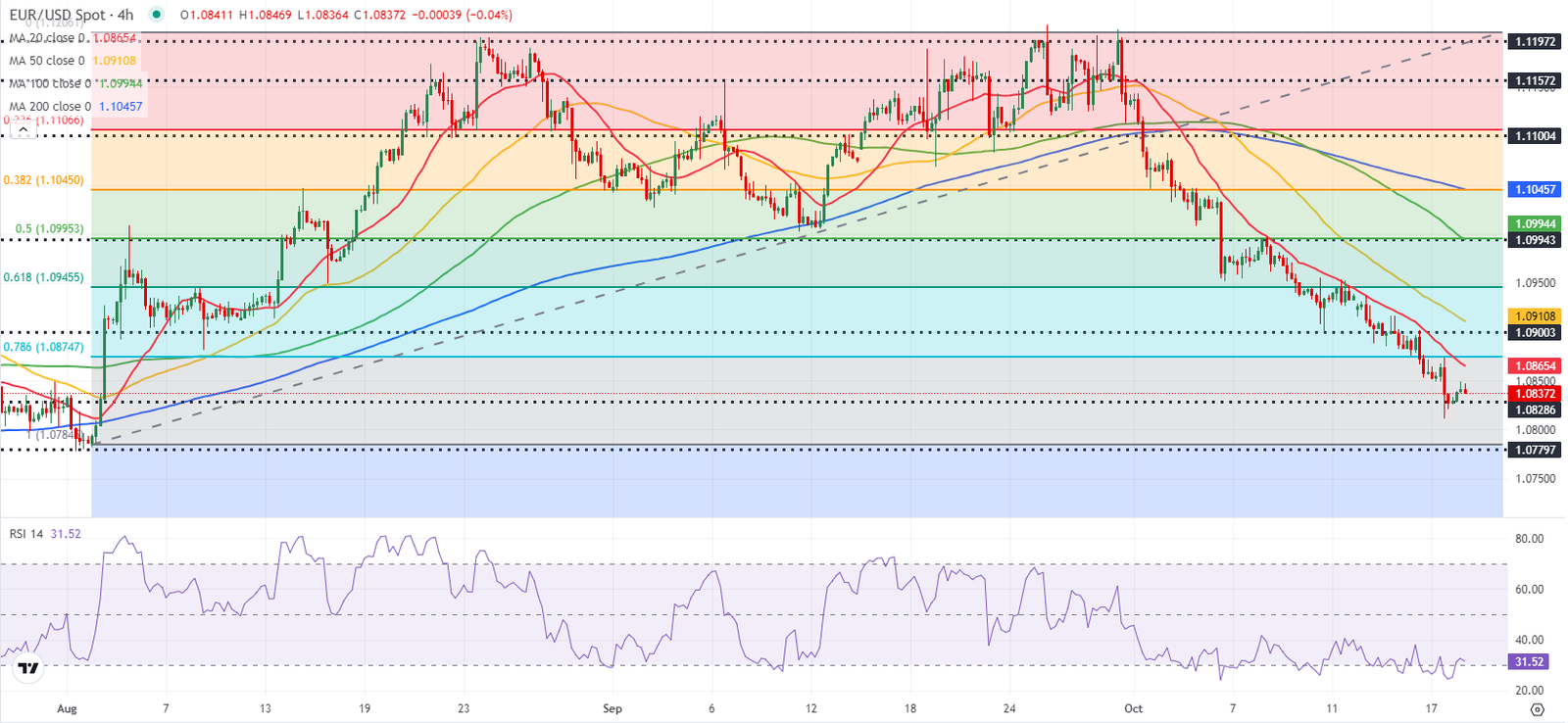- EUR/USD rebounds modestly after closing deep in the red on Thursday.
- The ECB lowered key rates by 25 bps after the October policy meeting, as expected.
- The technical outlook is yet to point to a buildup of recovery momentum.
EUR/USD extended its weekly downtrend and touched its lowest level in 10 weeks at 1.0811 during the American trading hours on Thursday. Although the pair trades in positive territory near 1.0850 in the European morning on Friday, the technical outlook doesn’t yet highlight a buildup of recovery momentum.
Euro PRICE This week
The table below shows the percentage change of Euro (EUR) against listed major currencies this week. Euro was the weakest against the US Dollar.
| USD | EUR | GBP | JPY | CAD | AUD | NZD | CHF | |
|---|---|---|---|---|---|---|---|---|
| USD | 0.95% | 0.22% | 0.55% | 0.16% | 0.54% | 0.64% | 1.13% | |
| EUR | -0.95% | -0.79% | -0.50% | -0.69% | -0.38% | -0.39% | 0.09% | |
| GBP | -0.22% | 0.79% | 0.29% | -0.04% | 0.44% | 0.42% | 0.86% | |
| JPY | -0.55% | 0.50% | -0.29% | -0.38% | 0.02% | 0.14% | 0.58% | |
| CAD | -0.16% | 0.69% | 0.04% | 0.38% | 0.32% | 0.50% | 0.79% | |
| AUD | -0.54% | 0.38% | -0.44% | -0.02% | -0.32% | 0.11% | 0.55% | |
| NZD | -0.64% | 0.39% | -0.42% | -0.14% | -0.50% | -0.11% | 0.42% | |
| CHF | -1.13% | -0.09% | -0.86% | -0.58% | -0.79% | -0.55% | -0.42% |
The heat map shows percentage changes of major currencies against each other. The base currency is picked from the left column, while the quote currency is picked from the top row. For example, if you pick the Euro from the left column and move along the horizontal line to the US Dollar, the percentage change displayed in the box will represent EUR (base)/USD (quote).
The European Central Bank (ECB) lowered key rates by 25 basis points (bps) as expected following the October policy meeting. In its policy statement, the ECB noted that it will continue to follow a data-dependent and meeting-by-meeting approach in determining the appropriate level and duration of policy restriction.
In the post-meeting press conference, ECB President Christine Lagarde acknowledged that the economic activity in the Euro area has been weaker than expected. Regarding the inflation outlook, Lagarde said that low confidence, geopolitical stress and low investment were posing downside risks to inflation. Lagarde’s dovish tone caused the Euro to stay under pressure in the second half of the day on Thursday.
The economic calendar will not offer any high-impact data releases on Friday. In the meantime, US stock index futures trade in positive territory in the European session.
In case risk-on flows dominate the action in financial markets ahead of the weekend, the USD could have a hard time gathering strength.
EUR/USD Technical Analysis
The Relative Strength Index stays slightly above 30 following the latest recovery attempt, suggesting that the bearish bias remains intact in the near term. On the upside, 1.0870 (Fibonacci 78.6% retracement of the latest uptrend) aligns as immediate resistance before 1.0900 (static level, round level). A daily close above the latter could discourage sellers and open the door for another leg higher toward 1.0950 (Fibonacci 61.8% retracement).
Looking south, interim support could be spotted at 1.0830 (static level) ahead of 1.0780 (beginning point of the uptrend) and 1.0740 (static level from April).
Euro FAQs
The Euro is the currency for the 19 European Union countries that belong to the Eurozone. It is the second most heavily traded currency in the world behind the US Dollar. In 2022, it accounted for 31% of all foreign exchange transactions, with an average daily turnover of over $2.2 trillion a day. EUR/USD is the most heavily traded currency pair in the world, accounting for an estimated 30% off all transactions, followed by EUR/JPY (4%), EUR/GBP (3%) and EUR/AUD (2%).
The European Central Bank (ECB) in Frankfurt, Germany, is the reserve bank for the Eurozone. The ECB sets interest rates and manages monetary policy. The ECB’s primary mandate is to maintain price stability, which means either controlling inflation or stimulating growth. Its primary tool is the raising or lowering of interest rates. Relatively high interest rates – or the expectation of higher rates – will usually benefit the Euro and vice versa. The ECB Governing Council makes monetary policy decisions at meetings held eight times a year. Decisions are made by heads of the Eurozone national banks and six permanent members, including the President of the ECB, Christine Lagarde.
Eurozone inflation data, measured by the Harmonized Index of Consumer Prices (HICP), is an important econometric for the Euro. If inflation rises more than expected, especially if above the ECB’s 2% target, it obliges the ECB to raise interest rates to bring it back under control. Relatively high interest rates compared to its counterparts will usually benefit the Euro, as it makes the region more attractive as a place for global investors to park their money.
Data releases gauge the health of the economy and can impact on the Euro. Indicators such as GDP, Manufacturing and Services PMIs, employment, and consumer sentiment surveys can all influence the direction of the single currency. A strong economy is good for the Euro. Not only does it attract more foreign investment but it may encourage the ECB to put up interest rates, which will directly strengthen the Euro. Otherwise, if economic data is weak, the Euro is likely to fall. Economic data for the four largest economies in the euro area (Germany, France, Italy and Spain) are especially significant, as they account for 75% of the Eurozone’s economy.
Another significant data release for the Euro is the Trade Balance. This indicator measures the difference between what a country earns from its exports and what it spends on imports over a given period. If a country produces highly sought after exports then its currency will gain in value purely from the extra demand created from foreign buyers seeking to purchase these goods. Therefore, a positive net Trade Balance strengthens a currency and vice versa for a negative balance.







